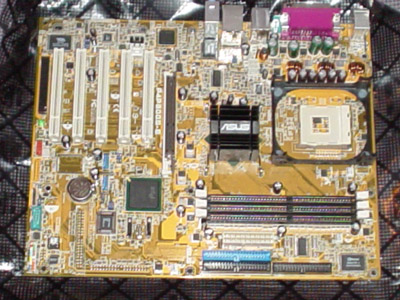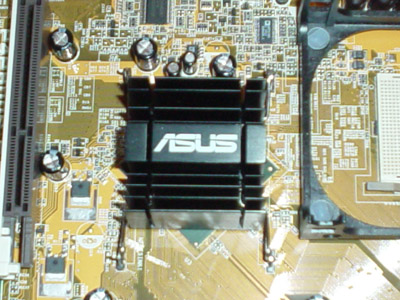ASUS P4P800S-E: Standing Out in the Crowd
by Evan Lieb on September 14, 2003 10:45 PM EST- Posted in
- Motherboards
ASUS P4P800S-E: Board Layout
The P4P800S-E’s general layout isn’t too shabby, though there are a few layout choices with which we take issue.Click to enlarge.
The P4P800S-E’s ATX connector location is on the preferable side of the motherboard, but is placed too low on the board for it to be a useful location. Unfortunately, standard PSUs often do not have an extra long ATX cable, and this becomes a problem with motherboards that have their ATX connectors located on the left-hand portion of the motherboard. This placement noticeably increases clutter and most likely will obstruct the installation/uninstallation of the CPU HSF, memory modules, and other components in that area. Of course, if you’re like most enthusiasts, you’ll be using a high-quality PSU with an extra-long ATX connector, and have nothing to worry about. Still, it’s difficult to overlook the fact that the vast majority of ATX cases come with standard PSU’s that have short cables, including the ATX cable.
Click to enlarge.
Thankfully, ASUS places the Primary and Secondary IDE connectors on the upper right-hand portion of the board, well above its mid section. We have always preferred this type of positioning because it makes it much easier to route the IDE cables that come bundled with all motherboards nowadays. Not only does the Primary and Secondary IDE connector’s location (high up on the motherboard) guarantee much less case clutter and better air flow, it avoids the possibility of not being able to use the top two drive bays of your computer case. Having used a countless number of motherboards that had the Primary and Secondary IDE connector locations much lower on the board, I can say first hand how ridiculous your computer will look if the top one or two bays aren’t filled with an ATAPI (optical) drive, such as a CD-RW or DVD-ROM.
One big negative aspect about the P4P800S-E’s layout is the location of the Floppy connector. Instead of being placed at the bottom of the motherboard, the P4P800S-E’s Floppy connector is located above the Primary and Secondary IDE connectors. This causes a big problem because all modern computer cases place the Floppy drive bay in the middle portion (or slightly below) of the case. This means that you’ll have to route your Floppy cable through your IDE cables, which can cause case havoc in terms of neatness, and even some airflow issues. This is quite a minor issue though, especially if you could care less about how neat the inside of your case is. There will be some enthusiasts that like to tinker and upgrade their computers frequently however, and so this Floppy connector location will be an additional annoyance.
Click to enlarge.
A positive layout decision for any motherboard is the location of its DIMM connectors. Users who upgrade and tinker their systems frequently will be quite pleased to see that the P4P800S-E’s DIMM connectors have no chance of colliding with an AGP video card when placed in the open position. This makes it possible for users to install or uninstall memory modules easily without having to uninstall their video card. We’ve detailed on countless occasions what a waste of time it can be to uninstall your video card. First you have to unscrew your video card, then you have to unplug your VGA cable, and finally you have to physically uninstall the video card from its AGP slot. All of this would be necessary just to upgrade or uninstall some memory modules. Thankfully, ASUS’ engineers didn’t overlook this common problem.
Click to enlarge.
Fortunately, ASUS places their North Bridge heatsink parallel to the edge of the board instead of at a 45 degree angle. This is a better location because it allows users to install the high powered copper CPU HSFs on the market without having to modify physically the North Bridge heatsink. In addition, this positioning helps with video card enthusiasts looking to add extra cooling to the backside of their video cards PCB, as the North Bridge heatsink will have no chance of colliding with the video card.














4 Comments
View All Comments
Anonymous User - Monday, September 29, 2003 - link
When you do test comparisons, could you please give the reasons for choosing the hardware you used.TheInvincibleMustard - Tuesday, September 16, 2003 - link
It's been asked before, but I'll ask again. Is there some way that you fine folks can highlight on the graphs the motherboard you're reviewing? It adds a lot to the ability to read the graphs meaningfully.Other than that, this sounds like a pretty sweet board for cheap! Good review.
Evan Lieb - Monday, September 15, 2003 - link
Thanks for the heads up #1, it's fixed.Take care,
Evan
Anonymous User - Monday, September 15, 2003 - link
Please check this link,http://www.anandtech.com/mb/showdoc.html?i=1865&am... for ASUS P4P800S-E: BIOS and Overclocking.
The setup screen photos show Copyright American Megatrends, and the review shows that the board uses Award BIOS = ??.